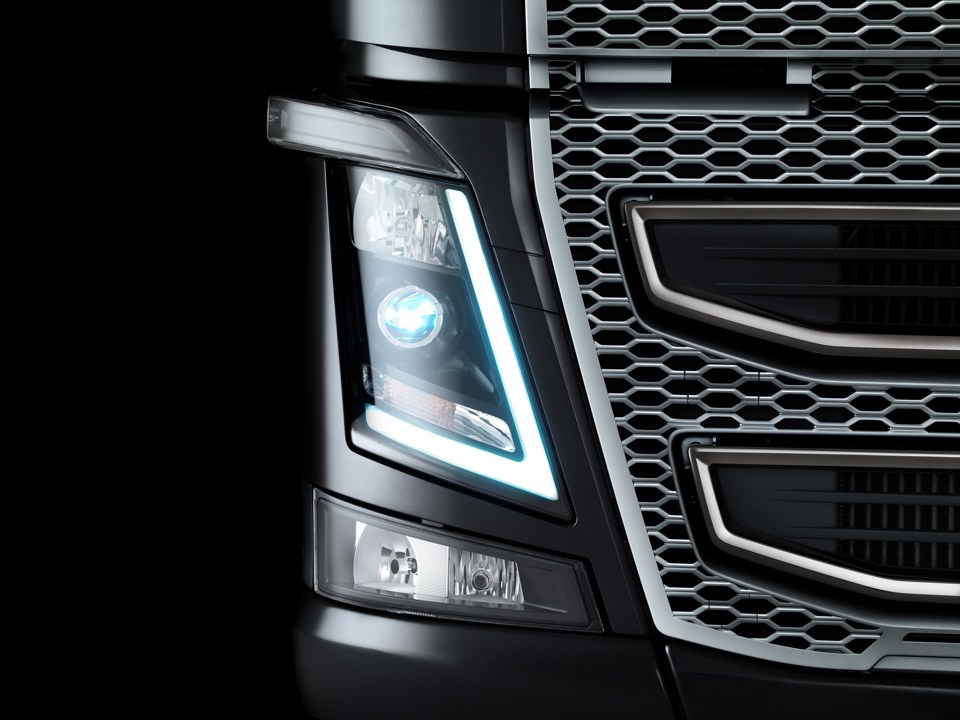Vehicle lighting is often taken for granted, but without headlights, brake lights or turn signals, the result on our roads would be carnage. Even interior lighting has a part to play in driver safety.
As with other safety add-ons, lighting is an area where the commercial vehicle industry has some catching up to do. Car manufacturers have accelerated developments in lighting, offering improvements such as laser headlights, night-vision cameras and LED interior accent lights.
The commercial market is catching up, but much of the technology on offer is still optional. Commercial Fleet took a look at the key aspects of commercial vehicle lighting and how they are being developed.
Halogen
Halogen headlamp technology still dominates the commercial vehicle industry. This is mainly because it is simple and cost-effective. With only three commonly used bulb types, replacements are easy to find and fit.
The biggest disadvantage is efficiency. The burning
filaments sap power from the vehicle’s electrical system and give about 1,000 hours of service before needing to be replaced.
Nonetheless, the ageing technology provides adequate illumination and is cheap to manufacture.
Xenon
For many years the only viable alternative to halogen, xenon lamps produce a cool blue light, which offers far greater illumination.
Officially known as high-intensity discharge (HID), these lamps have no filament. The light is created by an arc of electricity between two electrodes.
It’s often used in conjunction with high-beam lights (known as bi-xenon) and the beam pattern stretches much farther than traditional lamps.
The bulbs offer greater life-expectancy too, lasting twice as long as a halogen bulb (about 2,000 hours). They also draw slightly less power from the vehicle.
However, xenon systems are expensive, with each bulb costing more than £100. The headlight units are more complex due to the higher voltage and there is a risk of dazzling other road users.
LED
Light-emitting diodes, or LEDs, are currently the most popular lighting technology among car manufacturers, with even mainstream cars, such as the Vauxhall Astra, now featuring LED headlights.
The technology evolved from the increased use and
popularity of LED daytime running lights (DRLs). Since the mandatory fitment of DRLs was introduced, manufacturers have turned to LED technology to provide bright, long-lasting lamps that are cheap to make and replace when required.
There are many benefits of LED technology, such as low power consumption. If a vehicle uses a full LED lighting set-up, the energy saving is enough to affect fuel efficiency.
DAF is the only truck manufacturer to offer a full LED headlight set-up. The unit is produced by Hella and is currently optional.
Iveco is interested in developing a full LED solution and already plans to fit LED headlamps to the Daily van. Currently, only the Mercedes-Benz Vito can be specified with full LED front and rear lights.
LEDs also offer advantages for maintenance budgets, says Martin Flach, Iveco product director.
“If a driver is off-site and blows a halogen bulb, he will call out a mobile technician to change the bulb. This could cost the operator £50 to have a 50p bulb fitted. LED clusters are fit-and-forget, so costs are significantly reduced.”
LEDs are more visible and react quicker, meaning they have great safety advantages. With the cluster made up of many tiny LEDs, the design possibilities are far greater than conventional lamp units. Not only for size and shape but also the way the light works.
Car manufacturers have already adopted the technology and use it to create light signatures and even animated signals, such as scrolling indicators.
When braking, LEDs allow for different intensity levels depending on the harshness of the application, this means following drivers will be made more aware of heavy braking and some vehicles even flash the brake lights to ensure they are highly visible.
On the inside
The commercial sector is also moving to adopt LEDs in vehicle interiors and work spaces. Here too, benefits include lower lifetime costs and less battery drain, but the biggest dividend has been the contribution to safety.
Low-voltage LED lights have delivered brighter, better illumination, which has enhanced vehicle users’ ability to notice hazards and assess risks, directly reducing the risk of injury to drivers and other people who may access the interior space.
The difference can be impressive. Labcraft, a UK manufacturer of low-voltage LED interior lights, recently performed a light test on a factory-installed van light and found it provided 7 lux of light. However, replacing it with one of its high-performance LED lights showed a 900% increase in light output.
In the vehicle workspace, more and more operators are installing LED lighting in addition to the factory spec,
especially where the vehicle user will be expected to perform a task.
There is also a growing use of products with infrared-activated (PIR) switches that automatically illuminate an area.
So what about the future? Labcraft’s managing director, Nick Luscombe, says: “The future will see bright reliable low-voltage LEDs going into more applications that enhance safety.
“For example, Labcraft’s Banksman LED range. This is a driver aid designed to deliver additional light to the sides and rear of a commercial vehicle when manoeuvring or reversing. It reduces the risk of injury to people, and damage to property and the vehicle itself. Improving safety can mean reducing the time vehicles are off the road and the associated accident costs.
“We also believe that individual safety technologies, including lighting, will become further integrated to provide a more cohesive safety environment inside, and around, the vehicle. We see LEDs being used more strategically in
exterior applications which again will integrate with safety systems.”
Ultimately, as low-voltage LED lighting technology develops it will mean smaller lights, providing greater brightness, leading to new applications to enhance safety.

















Login to comment
Comments
No comments have been made yet.